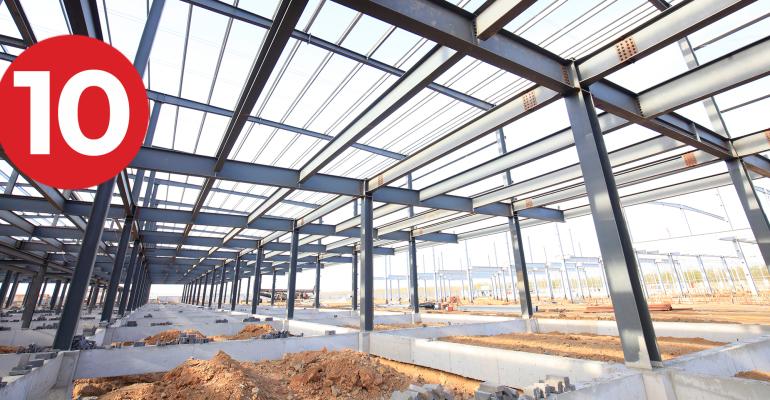- Red-Hot Warehouse Market Faces a Reality Test “Since the beginning of the pandemic, warehouse owners have been able to expand their footprint and raise their rates, thanks to soaring e-commerce demand and a dearth of warehouse space in many U.S. markets. But that growth is facing headwinds, including a slowdown in consumer spending and rapid inflation, which could test the resiliency of the business, industry watchers say.” (The New York Times)
- Intel Signs $30 Billion Funding Partnership with Brookfield to Finance Chip Factory Expansion “Intel Corp. has struck an unusual $30 billion funding partnership with Brookfield Asset Management Inc. to help finance its massive factory expansion ambitions, signaling some big investors are upbeat about the long-term demand for semiconductors. The agreement with the publicly traded Canadian asset-management firm is the first of what could be a series of such arrangements Intel pursues to underpin Chief Executive Pat Gelsinger’s push to make the company a leading contract chip maker and regain its manufacturing advantage over competitors in Taiwan and South Korea.” (The Wall Street Journal)
- America’s Office Glut Started Decades Before Pandemic “A surplus of empty office space threatens to hollow out U.S. business districts. Don’t blame the pandemic. America’s office glut has been decades in the making, real-estate investors, brokers and analysts say. U.S. developers built too many office towers, lured by federal tax breaks, low interest rates and inflated demand from unprofitable startups. At the same time, landlords largely failed to tear down or convert old, mostly vacant buildings to other uses. As a result, the country has too many offices and too few companies willing to pay for space in them. The rise of remote work during the pandemic aggravated a problem that was already emerging, analysts say.” (The Wall Street Journal)
- Co-Working Sector Making Swift Return “After a long period of uncertainty about the future of shared space, coworking has emerged as a viable solution to fill the gaps created by hybrid work, as well as a cost-saving alternative for struggling office tenants. According to the latest CommercialEdge office report, the nation’s shared space inventory as of July encompassed some 117.5 million square feet of space, representing 1.7 percent of total stock.” (Commercial Property Executive)
- In Vancouver, Indigenous Communities Get Prime Land, and Power “The newest players in Vancouver’s never-ending real estate drama don’t come from across the Pacific or from south of the border. They are the area’s oldest inhabitants, ensconced in this corner of Canada since long before what they call “contact” with European colonizers — and they had long been bystanders as a hyperactive market created fortunes and turned the city into the country’s priciest.” (The New York Times)
- Should CRE Plan for Permanently High Inflation? “If you think high inflation is a temporary thing and the world will be back to pre-pandemic normal, you’re at odds with some of the world biggest bond investors, according to a Bloomberg report. They figure the Fed’s goal of 2% inflation is largely a pipe dream, which is why they’ve loaded up on inflation-protected bonds, exposure to commodities, and keeping plenty of cash—yes, cash—on hand. What sustained low inflation during a long stretch of expanding globalization were cheap energy and labor.” (GlobeSt.com)
- Blackstone Is ‘Desperate’ for a Large Mall Presence; May Pay More for Market Value for Delhi’s Select Citywalk “Investment firm Blackstone, that is reportedly looking to acquire Delhi’s premium mall Select Citywalk, is “desperate” for a large mall presence in the metros, said sources. People in the know said that they might end up paying more than the market value for Select, considering the lure of the property. These comments come after media reports stated that Blackstone’s Indian retail portfolio arm, Nexus Malls, is in talks to acquire the premium mall located in South Delhi. Blackstone is ‘desperate’ for a large mall presence in the metros, which is limited so far. Therefore, they will pay more than market value for Select -- this property is marquee and will be of a huge strategic advantage in every sense. Among other things, it is a presence in Delhi and within the capital, a top-quality location,” said sources to Business Today.” (Business Today)
- Proptech and Feds Take On Indoor Air Quality at Schools “Since 2020, Congress has passed $189 billion in funding to address indoor air quality (IAQ) in elementary and high schools. Along with proptech innovations aimed at improving IAQ, schools have never had more funding and technological resources to combat air-borne diseases, including COVID-19 and triggers for asthma, and to promote a cleaner classroom environment. So far, though, much of the money remains unspent due in part to indecision over what technologies to use and the decentralized nature of school decision-making in general in the U.S.” (Commercial Observer)
- You May Soon Be Asked to Take a Pay Cut to Keep Working from Home “Working from home during the pandemic became a surprising success. Many workers enjoyed a better quality of life plus savings on commuting, office wardrobe and other expenses. Companies boosted productivity and lowered costs. Now as remote work looks likely to survive in some form for the foreseeable future, a battle is starting to brew over who should pocket those savings, with some employers arguing that working from home is a benefit that should be offset by lower salaries.” (Los Angeles Times)
- What Is ‘Hybrid Guilt’? Going to the Office Part Time May Be Worst Option “As companies increasingly implement hybrid policies, anxious workers have begun to gauge what the new social norm is, wondering if they’re going into the office enough or whether they should be showing face as much as their coworkers. That’s because the amount of time hybrid workers spend in office varies, a March Gallup survey found. Most said they’d go in half the time (38%), but 29% said they’d go in ‘sometimes.’” (Fortune)
0 comments
Hide comments





